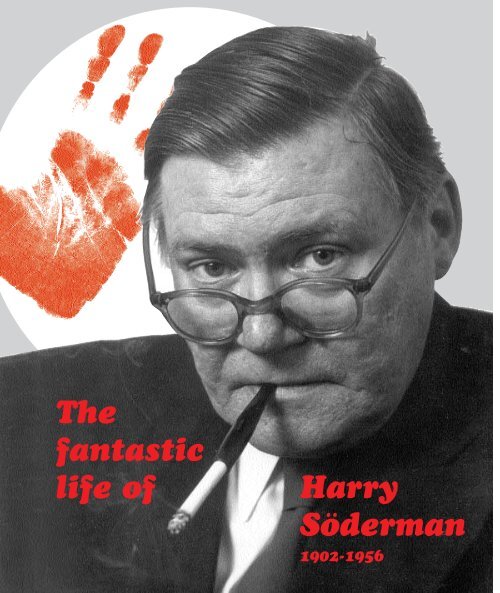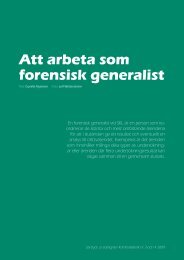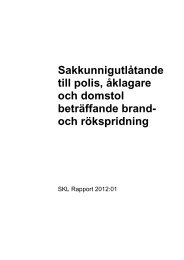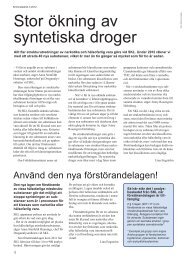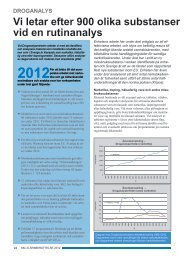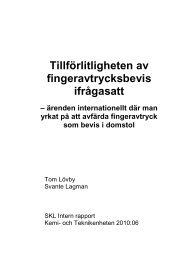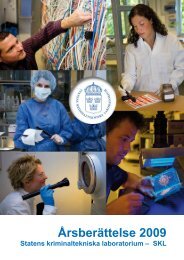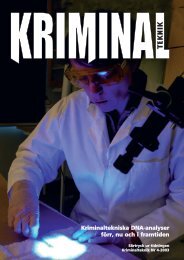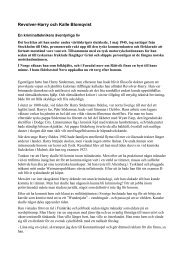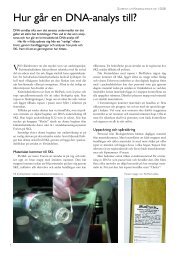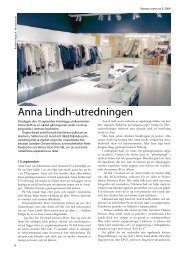Harry Söderman The fantastic life of - Skl
Harry Söderman The fantastic life of - Skl
Harry Söderman The fantastic life of - Skl
Create successful ePaper yourself
Turn your PDF publications into a flip-book with our unique Google optimized e-Paper software.
<strong>The</strong><strong>fantastic</strong><strong>life</strong> <strong>of</strong><strong>Harry</strong><strong>Söderman</strong>1902-1956
He learnt the subject working withthe famous Dr Locard in Lyon andbecame the first director <strong>of</strong> theNational Forensic Science Institute,the predecessor <strong>of</strong> SKL - <strong>The</strong>National Laboratory <strong>of</strong> ForensicScience.He had an enormous capacity, ashe was, at the same time, leadingthe Institute, writing books and performingmany extra tasks because<strong>of</strong> his reputation as an expert andorganiser. Being true entrepreneur,he was more devoted to developmentthan to administration, but hehad the right feeling for gatheringthe necessary co-workers to maintainhis enterprise.When we at the SKL wanted tocommemorate the 100th anniversary<strong>of</strong> <strong>Harry</strong> <strong>Söderman</strong>'s birth, wesoon found that it was impossible togive only one view <strong>of</strong> such anextraordinary achievement.We have therefore chosen threedifferent angles.<strong>The</strong> first is that <strong>of</strong> a journalistwho takes into account what thegeneral public <strong>of</strong> today might wantto know about the <strong>fantastic</strong> <strong>life</strong> <strong>of</strong><strong>Harry</strong> <strong>Söderman</strong>.<strong>The</strong> second is more <strong>of</strong> a formalaccount for <strong>Harry</strong> <strong>Söderman</strong>'s workwritten for the journal PoliceScience when he was still alive, andthe third is a view from one <strong>of</strong>today's European forensic scientists,who has looked into some <strong>of</strong>the archives.We hope these three aspects willgive, not only a reasonable coverage<strong>of</strong> the <strong>life</strong> and achievements <strong>of</strong><strong>Harry</strong> <strong>Söderman</strong>, but also goodreading.INGVAR KOPPPROFESSOR AND DIRECTOR, SKLForeword<strong>Harry</strong> <strong>Söderman</strong> lived an extraordinary<strong>life</strong>. Few have accomplished as much ashe did.He can be considered as the father <strong>of</strong>Swedish “kriminalteknik”, which encompassesthe whole Forensic Science laboratoryarea except forensic medicine andtoxicology.3HARRY SÖDERMAN 1934, PHOTO: LIBRARY OF INGRID SÖDERMAN
Revolver-<strong>Harry</strong> andKalleBlomqvist<strong>The</strong> adventurous <strong>life</strong> <strong>of</strong>a forensic scientistBY: KAIANDERS SEMPLERTRANSLATION: INGELA DELLBYIt is told that by the end<strong>of</strong> the Second WorldWar, May 1st 1945, hetook the night trainfrom Stockholm to Oslo,walked straight up tothe German commandantand declared thatcontinued resistancewould be madness.Together with aGerman motorcyclemessenger he then wentout to the dreadedGerman prison campGrini and personallyreleased the imprisonedNorwegian resistancemen.In Norway he was considered anational hero, and at Furudal north <strong>of</strong>Rättvik there is a bust in remembrance<strong>of</strong> him. In his native townNora, a square is now named afterhim.Actually, his name was <strong>Harry</strong><strong>Söderman</strong>, but after he had become adoctor <strong>of</strong> philosophy by test shootingweapons and comparing the grooves<strong>of</strong> the bullets, he was generally calledRevolver-<strong>Harry</strong>. He was an ardentdemocrat and anti-fascist and hemeant that the free society could onlybe sustained by legal security. Andlegal security in turn needs access tothe unambiguous technical production<strong>of</strong> evidence, for convicting theguilty as well as for acquitting theinnocent.By the end <strong>of</strong> the 1900th centurynorthern Sweden was to a great extenta lawless land. <strong>Harry</strong>'s father, Pehr<strong>Söderman</strong>, had been a county sheriffin Delsbo. His work as the guardian<strong>of</strong> the law seems to have had much incommon with the work <strong>of</strong> the sheriffsin the films <strong>of</strong> the Wild West.HARRY SÖDERMAN 1945, PHOTO: LIBRARY OF INGRID SÖDERMAN4
If we can trust his posthumous reputation,Mr. <strong>Söderman</strong> senior showedquite a few similarities with WyattEarp, the legendary sheriff <strong>of</strong> DodgeCity. <strong>The</strong> county sheriff was in a perpetualstate <strong>of</strong> feud with the illicit distillersin his region, and both partiesalways had their guns ready to fire. It isastounding that Mr. <strong>Söderman</strong> seniorsurvived all the ambushes, assaults andnightly fighting in the forest wherethey shot savagely at each other withtheir shotguns.However, when young <strong>Harry</strong> wasborn in 1902 the family had moved tomore civilised areas farther south in thecountry. <strong>Harry</strong> started school, but hedid not show any great inclination forstudies. <strong>The</strong> only subjects he was interestedin were chemistry and physics.<strong>The</strong> result was that he later entered thechemical vocational training school inMalmö from which he graduated in1923.Wood chemistry<strong>The</strong> intention was that <strong>Harry</strong> shouldbecome a chemist in the wood industry.But after he had practised forsome months at a wood company herealised that in order to get anywherein the world <strong>of</strong> timber, pulp and sulphatelye he had to add to his theoreticalknowledge. So he went toAltenburg in Germany and studiedwood chemistry in the very midst <strong>of</strong>the worst years <strong>of</strong> inflation in theWeimar Republic. After a year he hadhis exam - and in addition, he hadlearnt to speak German.But it wasn't forest chemistry that<strong>Harry</strong> dreamed about, but criminology,and he devoured everything hecould lay his hands on in this subject.But how could he ever become acriminologist? For getting a job withinthe police, you had to study law,something that was definitely not inhis line.After he had returned home anddone his military service in Sweden,he decided to start his career as achemist by taking a "Wanderjahr" - ayear <strong>of</strong> wandering the world. Perhapssomething would turn up in the meantime.First he stayed for some time inFrance and then he worked for a couple<strong>of</strong> months as a fireman on a NorthSea tramp steamer. But <strong>Harry</strong> was ayoung man with a will <strong>of</strong> iron and anunusual talent for innovative andunconventional thinking. He wantedto go farther away, he wanted to seethe Orient. He went home and turnedto the manager <strong>of</strong> a Swedish bicyclefactory with a radical suggestion:- Lend me a bike and I'll ride it toConstantinople and in that way I'llboost your firm, he said.A bicycle trip to Asia<strong>The</strong> bicycle factory owner was sosurprised that he consented, and<strong>Harry</strong> quickly packed his knapsack.Before he went away he also took theopportunity to arrange with thePHOTO: FROM THE BOOK “POLICEMAN´S LOT”Bicycle, elephants, canoes andcamels were <strong>Harry</strong> <strong>Söderman</strong>´smeans <strong>of</strong> transportation fromStockholm to Constantinople viaPersia through the Baluchistanidesert to India and China.Swedish Police Magazine and anotherSwedish weekly magazine to send thema travel diary, which would make histravelling funds last longer.<strong>Harry</strong>'s trip turned out to be longerthan he originally planned for. FromConstantinople, nowadays Istanbul, hecontinued eastwards. Through Persia,the Baluchistani desert, India andBurma he went all the way to Thailandand China. Everywhere he was keen onseeing the local police authorities andreporting home.It isn't quite the regular thing thatpeople should bike to China. At least notin Sweden. Here <strong>Harry</strong>'s exploit wouldnot be repeated until the 1990s. <strong>The</strong>n ayoung Swede named Göran Kroppcycled from Sweden to the Himalayas.<strong>The</strong>re he climbed the peak <strong>of</strong> MountEverest and then cycled back homeagain.Although, <strong>Harry</strong> never climbed thehighest mountain in the world, but hespent one and a half years <strong>of</strong> his journeyin the east. <strong>The</strong>n he turned back home.But what would become <strong>of</strong> him now?5
A meeting on amountain peakIn his autobiography "Policeman'sLot" (published posthumously in1956 in the USA) <strong>Harry</strong> <strong>Söderman</strong>tells that he decided to ramble in theSwedish mountains for some daysafter his return home. He went northand took lodgings at a small boardinghouse.One day he made a tour up to amountaintop nearby. <strong>The</strong> landladywondered whether he could considertaking some <strong>of</strong> the other guests at theboarding house up there. <strong>The</strong> wholething ended by forming a small expeditionconsisting <strong>of</strong> <strong>Harry</strong>, a clergyman,a lawyer and a Frenchman.After some hours they reached the top<strong>of</strong> the mountain. <strong>The</strong>re was one <strong>of</strong> theSwedish Touring Club's cabins forover-night accommodation, andwhere they had their picnic andstayed the night.However, the next morning theweather was bad with fog and snow,so the party had to stay in the cabinfor several days. <strong>The</strong>y passed thetime with card games and conversationwhile the storm howled round thedoors. <strong>The</strong>n it happened that <strong>Harry</strong>talked about his secret dream - tostudy criminal investigation for thefamous French criminologistEdmond Locard in Lyon."How interesting", said theFrenchman. "Locard is a good friend<strong>of</strong> mine. If you wish, I could writehim a letter <strong>of</strong> recommendation andask if he would take you on as a student."Some weeks later <strong>Harry</strong> had a letterfrom Mr. Locard wishing himwarm welcome to Lyon as a temporarystudent.<strong>The</strong> Lyon years<strong>Harry</strong> <strong>Söderman</strong>, now 24 years old,promptly left for Lyon. <strong>The</strong> Swedishwood industry missed a competentchemist.From this we learn to take advantage<strong>of</strong> the opportunity and the importance<strong>of</strong> polite conversations withstrangers on mountain peaks!In Lyon <strong>Harry</strong> learnt moderncriminal investigation from theground up.Locard assumed that the criminalalways leaves some traces, somethingwhich is now called the Locard principle:"Every contact leaves a trace!"Mr. Locard claimed.<strong>The</strong> marks a forensic technicianlooks for are such things as hair, textilefibres, fingerprints, nail dirt,bloodstains, sperm, shoe- and wheeltraces, dust and gravel, glass splinter,paint flakes, chemical substances.<strong>Harry</strong> learned all about chemicalanalyses, identification <strong>of</strong> fingerprints,investigation on the scene <strong>of</strong> acrime and many other things.PHOTO: FROM THE BOOK “POLICEMAN´S LOT”Locard´s staff at the forensic laboratory in Lyon in 1928. EdmundLocard is the second from the right in the bottom row and <strong>Harry</strong><strong>Söderman</strong> is the second from the right in the upper row.<strong>The</strong> monkey had been trained byhis cunning owner to become amaster cat burglar.PHOTO: FROM THE BOOK “POLICEMAN´S LOT”6
While in Lyon <strong>Harry</strong> also took theopportunity to take a doctor's degreeat the University <strong>of</strong> Lyon. Hisresearch work naturally concernedcriminal investigation. It was aboutanalysis and identification <strong>of</strong> pistolbullets. He was the first to make a scientificstudy <strong>of</strong> the individual markingson fired bullets that originatefrom the grooves in the barrel and thecartridge case due to the firing pin.In order to examine pistol bulletsquickly, he invented an apparatus hecalled a Hastoscope. It was a comparisonmicroscope where the bulletsinvestigated could be turned and rotated,either together or individually.After six years with Mr. Locard inLyon he thought himself skilledenough and returned to Sweden.Once back home he started a smallprivate bureau in Stockholm where he<strong>of</strong>fered forensic services, and aboveall, certificates <strong>of</strong> authenticity <strong>of</strong> documents.His work progressed moreand more successfully, and soon hewas appointed docent in criminologyat the University <strong>of</strong> Stockholm.He got a grant and went to theUSA to make contacts and study theforensic progress <strong>of</strong> the new world.Forming <strong>of</strong> SKAIn 1939 Doctor <strong>Harry</strong> <strong>Söderman</strong>became head <strong>of</strong> the recently formedSKA - <strong>The</strong> National Forensic ScienceInstitute - in Stockholm. <strong>The</strong> purpose<strong>of</strong> the institute was to give the policemeans and competence to make accurateanalyses and investigations onthe scene <strong>of</strong> a crime, and that was apredecessor to today's SKL - <strong>The</strong>National Laboratory <strong>of</strong> ForensicScience in Linköping.- Because the criminal alwaysleaves marks, <strong>Harry</strong> told his new colleaguesand pupils. It is only a question<strong>of</strong> having methods sophisticatedenough to detect them.PHOTO: FROM THE BOOK “POLICEMAN´S LOT”One <strong>of</strong> thefounders <strong>of</strong> Interpol<strong>Harry</strong> <strong>Söderman</strong> was now consideredone <strong>of</strong> the leading forensic techniciansin the world, and lectured bothin the USA and at Scotland Yard inLondon. In New York he took part inthe development <strong>of</strong> a new forensiclaboratory. Thanks to his excellentknowledge <strong>of</strong> languages - he spokefluent German, French and English -he naturally became a prominent figurein the international police collaboration,and he was one <strong>of</strong> thefounders <strong>of</strong> Interpol.<strong>Harry</strong> <strong>Söderman</strong>´s“Minnesbok förKriminalpolismän”(Memo book förpolice detectives)was first publishedin 1938.It vas considered tobe a memorandumfor the policedetective in hisfieldwork.<strong>The</strong> author wasvery clear that thecontents <strong>of</strong> the bookwere exclusively forpolicemen “because<strong>of</strong> the occurringdescriptions <strong>of</strong> theworking methods <strong>of</strong>criminals, etc.”<strong>Harry</strong> <strong>Söderman</strong>investigates a submachinegun in his<strong>of</strong>fice at the NationalForensic ScienceInstitute.During his journeys all overEurope and the USA he collected thelatest findings concerning criminalinvestigation. He summarised it all in"<strong>The</strong> Handbook <strong>of</strong> criminal investigation",a thick book <strong>of</strong> 680 pages,which accounted for forensic methodsfrom antiquity to our own time.Here he discussed matters, such asidentification <strong>of</strong> individuals by fingerprints,the collection <strong>of</strong> traces onthe scene <strong>of</strong> the crime and photographicdocumentation, witness psychology,analyses <strong>of</strong> powder stains,pistol bullets and bullet-holes, analysis<strong>of</strong> writing and other such things.PHOTO: BO LUNDQUIST7
Astrid Lindgren assecretaryIn 1939 he looked for a secretary forhis voluminous correspondence. Ayoung lady named Astrid Lindgrengot the job. Nobody knew then thatthis young lady in course <strong>of</strong> timewould become one <strong>of</strong> Sweden's mostbeloved writers <strong>of</strong> children's booksand internationally famous.Astrid Lindgren wrote in 1946 abook titled "Bill Bergson, MasterDetective", the first <strong>of</strong> what wouldbecome a sequence <strong>of</strong> three excitingbooks for young people. <strong>The</strong> booksare about the twelve-year-old KalleBlomkvist - or Bill Bergson, as is hisEnglish name - who is dreaming <strong>of</strong>becoming a detective, and who getsinvolved in a succession <strong>of</strong> nastycriminal cases together with hisfriends.8Astrid Lindgren has afterwardstold that it was during the time shewas <strong>Harry</strong> <strong>Söderman</strong>'s secretary thatshe got inspiration and forensic materialfor the books. In "Bill Bergson,Master Detective" (MästerdetektivenBlomqvist) Bill takes the fingerprints<strong>of</strong> a sleeping scoundrel according toall the recognised rules.In the following book, "BillBergson Lives Dangerously"(Mästerdetektiven Blomkvist leverfarligt), he carries out an advancedchemical analysis - the Marshianarsenic test - and discovers that a bar<strong>of</strong> chocolate is poisoned with arsenic.It is all breathtaking, especially foryoung readers at the age <strong>of</strong> twelve.<strong>The</strong> books were radio serials inthe 1950s, and were later also transferredto movies. Thus the forensiclaboratory technician and detectiveFront page <strong>of</strong> theSwedish magazineLektyr från 1952.It says:“New series <strong>of</strong>articles!<strong>The</strong> head <strong>of</strong> theNational ForensicScience Institute, Mr<strong>Harry</strong> <strong>Söderman</strong>,shares his memoirswith us.”Revolver-<strong>Harry</strong> <strong>Söderman</strong> in theguise <strong>of</strong> Bill Bergson became an idolfor all the boys in Sweden.But that was not enough. <strong>The</strong>police, and particularly the forensiclaboratory technicians, have neverhad such good standing in Sweden asduring the time when the BillBergson-fever raged.Well-read columnistBut it wasn't only in the shape <strong>of</strong> BillBergson that <strong>Harry</strong> <strong>Söderman</strong>reached the public. By this time,many popular weekly and monthlymagazines readily told about horriblecrimes and legal cases. <strong>The</strong>se magazineshired <strong>Harry</strong> <strong>Söderman</strong> as acolumnist and he told astounding storiesin the best Sherlock Holmesmannerfrom the exciting world <strong>of</strong>criminal investigation.Much <strong>of</strong> the material was from histime with Mr Locard in Lyon. Herewas, for instance, the story about theburglar with the strange fingerprints.Nobody could understand how thecunning jewel thief could get througha window on the third floor. Finally itwas discovered that a trained monkey
had committed the thefts. No wonderthe fingerprints were unusual.Many <strong>of</strong> the stories published inthe Swedish magazines "Kriminaljournalen","Lektyr", "Rekordmagasinet"and other popular press alsoappear in "Policeman's Lot".But let us return to the wartime.Training <strong>of</strong>Norwegian policemenIn the spring 1942, whilst the war wasraging, <strong>Harry</strong> <strong>Söderman</strong> had a requestfrom the Norwegian minister for justicein London. In Sweden there werequite a few Norwegians who had fledthe Nazi occupation <strong>of</strong> Norway, theminister explained. Would it be possibleto start a discreet training <strong>of</strong>Norwegian policemen in Sweden?<strong>The</strong> idea was that after the war, thesemen would replace those policementhat had become compromised byworking for the Quisling administration.Certainly, said <strong>Harry</strong>, and with hisusual capacity for unconventional andinnovative methods he took care <strong>of</strong> thematter. A number <strong>of</strong> "health farms"were opened where the Norwegianswere trained with the consent <strong>of</strong> theSwedish authorities.In reality it was not the matter <strong>of</strong>policemen but pure military training,this in flagrant violation <strong>of</strong> Sweden'sformal status as a neutral state. Butafter Stalingrad the political winds inSweden had shifted concurrently withthe fortunes <strong>of</strong> war.From the point when neutralSweden was left with no alternativeand was forced to be a puppet <strong>of</strong>Germany, the Swedish governmentwas more and more keenly sympatheticto the cause <strong>of</strong> the allies. <strong>The</strong> factthat <strong>Harry</strong> <strong>Söderman</strong> in someinscrutable way managed to find armsfor the Norwegian police detachmentcan be seen as a definite pro<strong>of</strong> <strong>of</strong> this.An expedition with members <strong>of</strong> the Norwegian resistance, the military,doctors and a chauffeur to save war captives at the Saltfjord in May1945. <strong>Harry</strong> <strong>Söderman</strong> is the third man from the left.Altogether 17 000 men weretrained between 1943 and 1945 at<strong>Harry</strong> <strong>Söderman</strong>'s "health camps".One <strong>of</strong> which was in the wood atGottröra, not far from the presentinternational airport <strong>of</strong> Stockholm,Arlanda.January 12th 1945 the firstNorwegian police troops were airliftedby the Americans from Luleå toKirkenes on the Norwegian ArcticOcean coast. <strong>The</strong> whole <strong>of</strong> Finnmarkhad been burnt and betrayed by theretreating Germans during theautumn <strong>of</strong> 1944, and Russian troopshad occupied the eastern Finnmarkup to the Tana River.<strong>Harry</strong> <strong>Söderman</strong>'s police troopsnow took over from the Russians,who compliantly pulled away to theirside <strong>of</strong> the border one month later.This was in accordance with thetreaty at Jalta between Churchill,Roosevelt and Stalin.This and many other things youcan read about in "<strong>The</strong> Battle <strong>of</strong> theArctic Scandinavia" by LarsGyllenhaal, Historiska media 2001.One <strong>of</strong> the Norwegians who wasflown up to the north <strong>of</strong> Norway fromSweden was Thor Heyerdahl, theman who later became world-famousfor his voyages with the rafts Kon-Tiki and Ra. Another was the father<strong>of</strong> my brother-in-law, a young mancalled Arvid Holte, who had fledNorway two years earlier.InternationalcommitmentsIn 1953 <strong>Harry</strong> <strong>Söderman</strong> decided toresign as head <strong>of</strong> the NationalForensic Science Institute to dedicatehimself totally to his internationalcommitments. He moved to the USAwith his family, and as a consultant heparticipated in the organisation <strong>of</strong>police organisations in a number <strong>of</strong>countries.1956 he was struck by heartinfarction during a commission inTanger. An adventurous <strong>life</strong> was at anend.PHOTO: LIBRARY OF INGRID SÖDERMAN9
<strong>Harry</strong> Soderman <strong>of</strong> Stockholm:Master CriminologistBY: CEDRIC LARSSONFROM: THE JOURNAL OF CRIMINAL LAW,CRIMINOLOGY AND POLICE SCIENCE,1952.<strong>The</strong> name <strong>of</strong><strong>Söderman</strong> is almostlegendary inEuropean police circles,and it is noexaggeration to saythat today he isEurope's leadingcriminologist andauthority on policesystems.While <strong>Söderman</strong>´s name isfamiliar in Americanpolice circles also, duelargely to his writings in police science,his very distinguished career isall too little known.<strong>The</strong> writer has had the privilege <strong>of</strong>several interviews with the eminentcriminologist in the course <strong>of</strong> hismost recent visit to America, andobtained from him the story <strong>of</strong> his<strong>life</strong>, which has been supplementedwith extensive readings into his considerablepublished works.10<strong>The</strong> career <strong>of</strong> Dr. <strong>Harry</strong> <strong>Söderman</strong>once more illustrates the ancientproverb that truth is stranger than fiction.One might almost suspect thatsuch a biography had been conjuredup from the fertile mind <strong>of</strong> a ConanDoyle or Baron Münchausen.Dr. <strong>Söderman</strong> was born August28, 1902 in Stockholm in a maternityhome, although his family did notlive in that city. He was one <strong>of</strong> tenchildren. His father, Per <strong>Söderman</strong>,was a Landsmann, a kind <strong>of</strong> sheriff,in Delsbo, Helsingland, in northernSweden. This area was once regardedas the most "hard-boiled" province inSweden. Per <strong>Söderman</strong> was marriedtwice, with seven children by the firstmarriage and three by the second.<strong>Harry</strong> was the eldest by the secondmarriage.Dr. <strong>Söderman</strong> says with a twinklein his eye that his interest in criminologydates from the time that his motherwas still nursing him, becausetwice in his infancy enemies <strong>of</strong> hisfather unsuccessfully tried to putexplosives in the <strong>Söderman</strong> house todestroy it.PHOTO: LIBRARY OF AFTONBLADET
A promising student<strong>Harry</strong> showed unusual promise inschool, and his father determined togive him a good technical educationand make him a chemist. His elementaryschooling was had in northernSweden, and when he finished elementaryschool, his father sent him tothe Chemical Institute <strong>of</strong> Malmöwhere he was graduated with honorsin 1920. At the age <strong>of</strong> 18 he went forspecial training to Germany, where hestudied legal chemistry as well aspulp and paper chemistry at theTechnical Institute <strong>of</strong> Altenburg, fromwhere he was graduated in 1922.Although his father wanted <strong>Harry</strong>to have a solid occupation as achemist in a Swedish paper mill, sucha prosaic <strong>life</strong> held little challenge tothis dynamic youth. While inGermany, he became a keen student<strong>of</strong> criminology, first more as a hobbythan anything else. Soon he wasstudying it seriously and becameknown as a capable person in thisfield.Two years in Asia<strong>Harry</strong> had been an avid reader <strong>of</strong> travelbooks in his adolescent years, andalways cherished a dream <strong>of</strong> one daytravelling through Asia. He was nowable to realize his fond ambition, forafter returning to Stockholm, he persuadedthe Swedish Police Journal tosend him on an Asiatic tour from 1924-26.He served as a correspondent forthis paper and reported on Asiatic policesystems and crime and delinquency inthese countries. He spent over two yearstravelling extensively in Asia, fromTurkey through the entire continent toChina. He journeyed through Syria,Mesopotamia, Persia, Baluchistan; andtraveled on camel-back through India,Burma, Siam, and French Indo-China.<strong>The</strong> famous Sir BasilThomson, earlierHead <strong>of</strong> the CentralIntelligence Division atthe Scotland Yard and<strong>Harry</strong> <strong>Söderman</strong>,flanked by the twoSiamese men thenstudying criminalinvestigation in Lyon.He was not content merely to visitthe large centers <strong>of</strong> population <strong>of</strong>these countries, but constantly pushedback into the hinterland in his criminologicalhegira. His dispatches wereread with great interest throughoutScandinavia and by criminologists <strong>of</strong>all the leading capitals <strong>of</strong> Europe.When he returned, he found himselfalready famous at the age <strong>of</strong> 24.Back in EuropeReturning to Europe, he becameassistant to Dr. Edmond Locard at theFrench State Police Laboratory atLyons from 1926 to 1928. Whilethere he took the degree <strong>of</strong> Doctor <strong>of</strong>Science at the University <strong>of</strong> Lyons,getting that degree with "TresHonorable" mention.He now embarked in earnest onhis <strong>life</strong>'s work in criminology. He waselected a member <strong>of</strong> the InternationalAcademy <strong>of</strong> Criminal Science inVienna, in 1929. That same year hewas elected assistant editor <strong>of</strong> RevueInternale de Criminalistique, publishedin Lyons, a post he held formany years. In 1929 he spent severalmonths in France as a special instructorto a mission from Siam underPrince Vongsa Nirajra teaching theseSiamese modern scientific policemethods.Returning to Sweden in 1930, hewas made chief editor <strong>of</strong> NordiskCriminal Teknisk Tidskrift (NordicJournal for Police Science) the mostnoteworthy publication in its field innorthern Europe. Besides teaching atthe University <strong>of</strong> Stockholm, he wasalso appointed by a Royal Swedishcharter to become an instructor inpolice science to the higher <strong>of</strong>ficialsin the Swedish Royal State Police.In the years that followed hisfame grew by leaps and bounds. Hewas assigned by the Swedish governmentin dozens <strong>of</strong> instances to investigatecases <strong>of</strong> arson, serious theftcases, and murder, throughout thewhole <strong>of</strong> Scandinavia, when the localpolice authorities could not copewith them.In a surprising percentage <strong>of</strong> allthese cases, through the use <strong>of</strong> scientificdetection methods, he wouldtrack down the perpetrator <strong>of</strong> thecrime.11PHOTO: FROM THE BOOK “POLICEMAN´S LOT”
In 1931 he was named a member<strong>of</strong> the Royal Parliamentary TechnicalCommittee which investigated theriots at the sawmills in Ådalen,Sweden. In 1934 he was made a specialinvestigator into the celebratedReichstag Arson case which madehistory. <strong>The</strong> criminologist reportedhis findings, in this case for a leadingStockholm paper. He was the onlyperson other than the Nazi <strong>of</strong>ficialsto speak with the suspect, Van derLubbe, in prison.<strong>Söderman</strong>'s considerable knowledge<strong>of</strong> chemistry and science ingeneral were put to excellentuse in combatting crime,and he devised manynew methods or applications<strong>of</strong> science incrime-solving, involvingballistics, fingerprints <strong>of</strong>dead bodies, footprints,burglary investigation, postaltheft investigation, dust analysis,espionage, and similarfields.He came, however, to be bestknown internationally through hiswritings. His first book was publishedin Stockholm in 1927 when he wasbut 25 : Brottets Värld (<strong>The</strong> World <strong>of</strong>Crime). <strong>The</strong> following year anotherwork appeared under his name in theFrench language and published atLyons: L'Expertise des Arms a FeuCourtées. He published also a largenumber <strong>of</strong> technical monographs inlearned journals and specialized periodicals.His fame reached much higher in1930 upon the appearance <strong>of</strong> whatpromised to be a definitive work onpolice science: Handbok iKriminalteknik (Handbook o f PoliceScience) in which he collaborated withErnst Fontell, Police Commissioner <strong>of</strong>Gothenburg. This Handbook - totalling12675 pages - was the precursor <strong>of</strong> hisclassic Modern Criminal Investigation,later to make such a success on bothsides <strong>of</strong> the Atlantic. <strong>The</strong> 1930Handbook is written in clear, readableSwedish prose, and well illustrated, butwas handicapped by the fact that itsaudience was limited to persons whocould read Swedish.In 1930 <strong>Söderman</strong> published inFrench an authoritative volume on fingerprints:Etude sur les EmpreintesDigitales.theAllaboveworks have beenwidely quoted in French,German, Spanish, South American,and English works on crime.Studies in AmericaIn 1933 <strong>Söderman</strong> obtained a fellowshipfrom the Swedish AmericanFoundation to study American policesystems. He spent a whole year in theNew York City Police Departmentstudying their methods, and made awide circle <strong>of</strong> friends, among them JohnJ. O'Connell, late Chief Inspector.After a year with the New YorkPolice, <strong>Söderman</strong> and O'Connell wereentrusted with the task <strong>of</strong> founding thenew police laboratory. This consumedabout another year. <strong>Söderman</strong>, meanwhile,had used the time to good advantageto visit police departments <strong>of</strong> otherlarge American cities, and the <strong>of</strong>fices <strong>of</strong>the F.B.I. in Washington.<strong>Söderman</strong> all this time felt thatthere was ample room for a goodbasic work on criminology for policestudents everywhere, written inEnglish, which would parallel in contenthis 1930 Handbook whose utilityhad been greatly circumscribed bythe fact that it was in Swedish. Hetalked the matter over with his friendO'Connell, and after many exploratoryconversations, the two decided toteam up and produce a book underjoint authorship, using the unparalleledresources <strong>of</strong> the New YorkPolice Department and <strong>Söderman</strong>'swide continental experience as background.Modern CriminalInvestigationThus it was that ModernCriminal Investigation by<strong>Söderman</strong> and O'Connell madeits initial appearance in 1935 underthe imprint <strong>of</strong> Funk & WagnallsCompany. This volume was destinedto make history in the literature <strong>of</strong>police science. <strong>The</strong> first edition(which is now a collector's item) had24 chapters, bibliography and index,and totalled 461 pages.It was well illustrated with photographsand line-drawings and wonalmost instantaneous acceptance as astandard in its field throughout thepolice world. Sales <strong>of</strong> the first printingwere so rapid that it was quicklyexhausted. Many other printings followedin quick succession. In the nextfive or six years the book wentthrough three editions and 18 printings.Total sales were never <strong>of</strong>ficiallydivulged by Funk & Wagnalls, butfrom informal conversations with<strong>of</strong>ficials <strong>of</strong> that firm, the writer estimatesthat sales in America alonemust have totalled close to 75,000.“HANDBOK I KRIMINALTEKNIK” PHOTO: BO LUNDQUIST
DRAWING BY OTTO WENDELStatens Kriminaltekniska Anstalt at Bergsgatan, Stockholm 1939Besides the English editions, however,the book was translated into a halfdozendifferent languages, includingFrench, German, Swedish, Spanish, andJapanese.In 1939 a South American editionwas published in Buenos Aires, some3 700 copies being printed. It wastranslated by Germãn Salgado <strong>of</strong> theBuenos Aires Police Department andDr. Antonio L. Beruti, a judge in theSupreme Court <strong>of</strong> that city. Althoughno exact figures are obtainable, aconservative estimate would placeforeign language copies <strong>of</strong> the<strong>Söderman</strong>-O'Connell book at about25,000. This would place total sales<strong>of</strong> the book in the 100,000 bracket,thought to be a record for a work inthis field.A completely revised and rewrittenedition, comprising thirty chaptersand 576 pages, was published inFebruary, 1952. It was issued asunder the joint authorship imprint onthe title-page, although O'Connellpassed away in 1947, so virtually theentire burden <strong>of</strong> revision has fallen on<strong>Söderman</strong>'s shoulders.But to get back to <strong>Söderman</strong>'scareer in the thirties-after leavingNew York in 1935 he again returnedto Sweden and taught at theUniversity <strong>of</strong> Stockholm. He managedto find time to do some work forthe International Police Commissiondealing with the issuance and standardization<strong>of</strong> passports, designed tocombat illegal traffic in this field.<strong>The</strong> year 1937 <strong>Söderman</strong> spent inDublin, where he was principal adviserin the reorganization <strong>of</strong> the IrishState Police.SKAIn 1939 the Swedish Parliament createda kind <strong>of</strong> Swedish version <strong>of</strong> theF.B.I. called Statens KriminaltekniskaAnstalt, or National Institute<strong>of</strong> Technical Police. <strong>Söderman</strong> wasnamed its first director, a post whichhe has retained to the present time,although he is gone so much he has tohave competent understudies to carryon in his absences. Dr. <strong>Söderman</strong> wasgiven a free hand in setting up theNational Institute, which he dividedinto two units. <strong>The</strong> first division wasthe laboratory division and dealt withall kinds <strong>of</strong> scientific and technicalmethods for combatting crime. <strong>The</strong>second division was administrative incharacter and carries on the multifariouspaper work inevitably entailed inefficient criminological investigation.<strong>The</strong> National Institute acts as aclearinghouse throughout Scandinaviafor fingerprint registrations,criminal records and data <strong>of</strong> all types,and related functions. Besides this,the Institute has extensive archives <strong>of</strong>crime records, a "Rogue's Gallery,"serves as a central passport institutionfor the country and handles all relationswith foreign police, publishes apolice bulletin, and sends out speciallytrained agents for the examination<strong>of</strong> scenes <strong>of</strong> crime at the request <strong>of</strong>local authorities. It has extensive andmodern laboratories which are consideredto be among the best inEurope.Swedish Police<strong>The</strong> Police School in Stockholm(where Dr. <strong>Söderman</strong> teaches) is one<strong>of</strong> the most extensive in the world.<strong>The</strong> passing <strong>of</strong> its examinations iscompulsory for every rank up to commissary<strong>of</strong> police (superintendent,English style; captain, Americanstyle).<strong>The</strong> Swedish state police set-up israther unusual. This force is chieflyconcerned with policing the rural districtsand has branch <strong>of</strong>fices in everyone <strong>of</strong> the 25 provinces. <strong>The</strong> detectivesand patrolmen are loaned outfrom the local forces for a certain timebut paid by the government, and the13
PHOTO: LIBRARY OF INGRID SÖDERMANdifferent state police forces are mainlyhandled by the chief public prosecutor<strong>of</strong> the province. <strong>The</strong> head <strong>of</strong> the statepolice is formally an assistant commissionerin the Stockholm policedepartment. <strong>The</strong> police forces <strong>of</strong>Sweden number about 7600 men.World War IIDuring World War II, <strong>Söderman</strong> wasplaced by his government in charge <strong>of</strong> athen very confidential project <strong>of</strong> organizingNorwegian and Danish policetroops raised in Sweden during that conflict.<strong>The</strong> Norwegian contingent numberedabout 15,000 and the Danish3,000. <strong>The</strong>ir mission was to be ready theday Germany capitulated to rush intotheir respective countries and preservelaw and order. This they accomplishedcapably, in close cooperation with theSwedish General Staff and the Alliedauthorities.Shortly before the ending <strong>of</strong> WorldWar II <strong>Söderman</strong> was sent to occupiedOslo on a bold mission. <strong>The</strong>re were atthat time about 7,000 political prisoners<strong>Harry</strong> <strong>Söderman</strong> in Norway,1945.<strong>Harry</strong> <strong>Söderman</strong> advocated that the German police should be armed.This made the East German press call him "Revolver-<strong>Harry</strong>", a nicknamethat followed him till he died and even afterwards, presumably becauseit seemed so appropriate. As we all know, he had both taken his doctor'sdegree in the identification <strong>of</strong> firearms and armed the Norwegian policetroops. Here at the farewell party in Germany in 1951, he makes ajoke about his nickname.(Source: Erik <strong>Söderman</strong>)held by the Gestapo in Norway, and<strong>Söderman</strong> was busy bargaining on howto get them out and into Sweden inbuses, when the war suddenly ended.<strong>Söderman</strong> in a characteristic decisivefashion, seized the initiative and freedthese unfortunate prisoners on his ownresponsibility and for a time was a sort<strong>of</strong> police chief in Oslo until theNorwegian authorities could move inand take over. Later the King <strong>of</strong> Norwaydecorated him with the DistinguishedService Medal <strong>of</strong> Norway for this feat.This medal is normally reserved forbravery on the battlefield.In the post-war years, <strong>Söderman</strong> hasacted as Reporter General to theInternational Criminal PoliceCommission, a post which requirestravel, correspondence, and writing.This supra-national organization hasamong its members police organizationsfrom all over the free world, suchas Scotland Yard and similar groups. Ithas as its aim the cooperation <strong>of</strong> thepolice systems <strong>of</strong> the free world in combattinginternational crime.Reorganization <strong>of</strong>German PoliceDr. <strong>Söderman</strong> had an interesting assignmentduring the year 1951. Since 1946the Germans in the Allied sections rantheir own police under Allied supervision.However, when the BonnRepublic was set up, it became apparentthat there was need for the reorganization<strong>of</strong> the German police by an impartialoutside expert. Dr. <strong>Söderman</strong> waschosen for this tough assignment, andfrom March to December 1951 spentmost <strong>of</strong> his time and energy at this formidabletask.<strong>The</strong>re was established in Wiesbadena Federal Office <strong>of</strong> Crime Investigation(Bundeskriminalamt). This <strong>of</strong>fice maintainslarge laboratories, publishes thePolice Bulletin, keeps a central file <strong>of</strong>fingerprints and other crime records,and sends out trained agents to aid thelocal police if so requested.<strong>The</strong> Office has limited executivepowers. It maintains in the capital,Bonn, a special squad <strong>of</strong> detectives forPHOTO: LIBRARY OF INGRID SÖDERMAN14
the protection <strong>of</strong> the president, cabinetmembers, and the diplomatic corps. <strong>The</strong>Federal Office <strong>of</strong> Crime Investigationhandles all relations with foreign policeand is the connecting link with theInternational Criminal PoliceCommission. Needless to say, Dr.<strong>Söderman</strong> is the principal architect inthis reorganization <strong>of</strong> the German policesystem.Personal <strong>life</strong>As for his personal <strong>life</strong>, Dr. <strong>Söderman</strong>was married in 1935 to Ingrid Beckman.<strong>The</strong>y have two sons: Pehr born in 1936and Erik born 1946. <strong>The</strong> <strong>Söderman</strong>s liveon an estate 30 miles south <strong>of</strong> Stockholm.Politically Dr. <strong>Söderman</strong> has wisely neverbeen active.He is a member <strong>of</strong> the Swedish"Farmers Party" and was once persuadedto run as a candidate from his district toParliament, but was not elected, probablyto the disgust <strong>of</strong> the criminal world wherethey would prefer to see him do anythingbut chase criminals. In conversation,<strong>Söderman</strong> loves to refer fondly to his"farm," crops, and animals. In his somewhatrare uncriminological moments, hestyles himself a "farmer."During his distinguished career,<strong>Söderman</strong> has won a host <strong>of</strong> honors andconferments by foreign governments,police societies, and learned bodies, toonumerous to mention. <strong>Söderman</strong> neverdisplays any <strong>of</strong> his awards, even to intimates,or talks about his honors, since heis a man <strong>of</strong> considerable modesty. Hedresses very simply, and one would neversurmise just from looking at him casuallythat he was the foremost criminologist <strong>of</strong>Europe. <strong>Söderman</strong> is a prolific writer andindefatigable researcher, and if someambitious librarian ever made a completebibliography <strong>of</strong> his writings there wouldprobably be 150 to 200 titles to list.<strong>Söderman</strong> today, at fifty years <strong>of</strong>age, stands at the apex <strong>of</strong> his career, onewhich has been <strong>of</strong> great benefit tomankind throughout the world.<strong>Söderman</strong>'s great contribution to criminologyhas been to adapt and extend thediscoveries <strong>of</strong> science, chiefly biology,physics, and chemistry, during the pastthree decades, to the field <strong>of</strong> police science.He is no armchair criminologist,either, but to perfect his knowledge <strong>of</strong>criminal investigation, has visited hundredsif not thousands <strong>of</strong> scenes <strong>of</strong>crime <strong>of</strong> every known type. His skill,patience, tact, industry, and thoroughnesshave also made him quite popularwith all police groups he has workedwith. He has personally solved scores <strong>of</strong>baffling crimes in his <strong>life</strong>time, by theuse <strong>of</strong> scientific methods <strong>of</strong> criminalinvestigation, and many cases could beset forth if space permitted.A genial knack<strong>Söderman</strong> is an affable, forthright individual,with a saving sense <strong>of</strong> humorand a genial knack <strong>of</strong> making friendswherever he goes. On one or two occasionswhen in New York City, he hasgiven entertaining and diverting lecturesbefore such groups as the MysteryWriters <strong>of</strong> America, Inc., drawing anecdotesand stories from his rich fund <strong>of</strong>personal experience, which are asbreath-taking as any Sherlock Holmesyarn. Like most Swedes <strong>of</strong> education,he speaks English with ready facility.In Western civilization in the pastfew decades there has gradually developeda new science which in America iscalled criminal investigation or policescience.In Europe it is usually termed policescientifique or technique policiere. Asfor the continental terminology, it israther difficult to say which <strong>of</strong> theseterms is preferable. <strong>The</strong> former refers toa given, definite science and the latter tothe practical application <strong>of</strong> that science.Both are important phases in preservinglaw and order.It is a sad truth that criminals alwaysseem to take advantage <strong>of</strong> the latest discoverieswithin scientific progress in theperpetration <strong>of</strong> many <strong>of</strong> their crimes.<strong>The</strong>refore society owes a great debt <strong>of</strong>gratitude to men like <strong>Söderman</strong>, whoseek to utilize the latest advances <strong>of</strong> sciencein combatting crime. It is a basictenet <strong>of</strong> <strong>Söderman</strong>'s philosophy that thepolice, fighting as it does an <strong>of</strong>tenuneven battle to protect society, hasevery reason in the world to keep in stepwith the latest developments <strong>of</strong> science.<strong>Söderman</strong>´s niche in the criminologicalhall <strong>of</strong> fame is assured, and it isa considerable niche. His career, it ishoped, is far from over, but his famewould be assured on the basis <strong>of</strong> whathe has already done. His name is asfamiliar in Sweden as that <strong>of</strong> J. EdgarHoover in America. His name takes itsplace with that honored group who havedone so much to protect society fromthe ravages <strong>of</strong> evil and misguided menwho form the criminal fringe <strong>of</strong> everygeneration.A tribute to<strong>Söderman</strong>It is a tribute to <strong>Söderman</strong> to say thathe is far more than a great Swedishcriminologist. He does, in fact,belong to the entire world <strong>of</strong> freesociety, for his researches, discoveries,and achievements have beenmade available to the free world. Hiseminent name belongs with that honoredcompany <strong>of</strong> Bertillon, Gross,Galton, Locard, Heindl, Balthazard,Wentworth, Van Ledden, De Rechter,Minovici, Osborn, Mitchell, andmany others - all great names in theannals <strong>of</strong> criminology - and who haveleft society far safer and strongerbecause they have lived.THIS ARTICLE WAS FIRST PUBLISHED IN THE JOURNALOF CRIMINAL LAW,CRIMINOLOGY AND POLICE SCIENCE.VOL. 43, NO. 1. MAY-JUNE, 1952.15
<strong>Harry</strong> <strong>Söderman</strong>A Great Pan-EuropeanCriminalistThis is also probably why hebecame known in circleswhere forensic scientists arerarely known : in police circles.This, in my mind, is an indicationthat he had a clear, modern and forwardlooking vision <strong>of</strong> the role <strong>of</strong>forensic science; a vision that manyforensic scientists still lack todayensconced in their specialist's views<strong>of</strong> “their” science for the law, ratherthan science in its broadest sense as aprocess useful in determining truth(identity, cause, circumstances) asmuch as possible for the judiciary.16BY PROFESSOR PIERRE A. MARGOT, PHDINSTITUT DE POLICE SCIENTIFIQUE ET DE CRIMINOLOGIE, LAUSANNEHARRY SÖDERMAN is a name that I firstheard when I was a student <strong>of</strong> forensic sciencein Lausanne some 25 years after hisdeath. It did not come up attached to aspecific field like Bertillon (anthropometry),Galton (dactyloscopy), Goddard (firearms),Osborn (Questioned documents),but more like the name <strong>of</strong> his masterEdmond Locard, a generalist, a criminalistin its pure dimension looking at evidencenot only as a means <strong>of</strong> proving in court,but also as lead-giving in the investigation.This needs polyvalence, observationcapabilities, intelligence, to transformdata into meaningful information.Curiosity and the development <strong>of</strong> amultilingual culture helped make<strong>Harry</strong> <strong>Söderman</strong> one <strong>of</strong> the foremostmind in forensic science.Not knowing him directly, it is byresearching through archives that Istarted to understand the importance<strong>of</strong> his contribution and to regret hisearly disappearance. Forensic scientists<strong>of</strong> today should be aware <strong>of</strong> arich contribution whose validity isstill evident some 50 years later!My contribution here is minimal,but shows through anecdotes,notes, contributions by his peers(which do not appear in most publishedmaterial I have seen inEnglish) how highly regarded<strong>Harry</strong> <strong>Söderman</strong> was and howinnovative he could be, facingpragmatic problems.Relation to LocardIt is obvious, throughout his writing,that <strong>Harry</strong> <strong>Söderman</strong> had anadmiration for Edmond Locard, histhesis director, mentor, colleague,friend.This relation and admiration canbe felt while reading the first 190pages <strong>of</strong> the book Policeman's Lot(<strong>Söderman</strong> 1956).What is less obvious and lesswell known is that this admirationwas reciprocal, arose from the time<strong>Harry</strong> <strong>Söderman</strong> was a student <strong>of</strong>Locard in Lyon, and remained afterthe dreadful tragedy that splitEuropeans in WWII. <strong>The</strong>re are two"preface" written by Locard in1928 (<strong>Söderman</strong> 1928) and in 1956(<strong>Söderman</strong> 1956) that never appearin English editions or versions, butthat are telling witnesses <strong>of</strong> thisclose relationship. It is perhaps betterto start with the preface writtenin 1956, when Locard learns <strong>of</strong> thedeath <strong>of</strong> his friend. I freely translatethe whole preface which I willtry to relate to other documentslater in this presentation.
PHOTO: FROM THE BOOK “POLICEMAN´S LOT”Doctor Edmond Locard, the famous head <strong>of</strong> the forensic laboratory inLyon, <strong>Harry</strong> <strong>Söderman</strong>´s friend and tutor, expert on crimes, but also onmusic and theatre.“At the very moment I was goingto write this preface, I learn with sucha deep sorrow, the death <strong>of</strong> my dearfriend <strong>Harry</strong> <strong>Söderman</strong>, who disappeared,still very young, when he wasgoing to be able to take, finally, sucha well deserved rest.What a magnificent <strong>life</strong> he hashad, or better, what a story! <strong>Harry</strong><strong>Söderman</strong>, traveller without rest, hasnot only gone round the vast world,but has explored all the fields <strong>of</strong>knowledge. I feel honoured to havehad him as a student, the most brilliant<strong>of</strong> all my students. But this greatcriminalist has learnt many otherthings than the art <strong>of</strong> detecting andconfounding criminals. Chemist,graphologist, prodigiously polyglot,enriched by an immense reading, hehad accumulated in his unique brainwhat would have been the richness <strong>of</strong>twenty elite's intelligences.Moreover he was a producer/adoer. He had the art <strong>of</strong> drawing fromwhat he knew for the better good <strong>of</strong>his friends and others. During themany years he spent near me what Ihave got to do due to his initiatives! Ishould say his darings. It is him who,literally, made me create the RevueInternationale de Criminalistique.Beside me, he has pushed to createthe International Academy that Vanledden Hülsebosch, Popp, Türkel andBisch<strong>of</strong>f could perhaps not have managedto organise, nor to maintainwithout him. And how to forget that,when I was backing from the terrifyingenterprise <strong>of</strong> composing the sevenvolumes <strong>of</strong> the Traité deCriminalistique, it is him who decideda careless editor, my friendJoannès Desvignes, to risk the dangerousadventure "PM addtion(Locard 1931)!"Since then, <strong>Harry</strong> <strong>Söderman</strong> hasplayed a historical role where hiscourage without capitulation joinedhis spirit <strong>of</strong> initiative. But at the heat<strong>of</strong> the action, he never ceased to be avery great criminalist.Secretary <strong>of</strong> the InternationalCommission <strong>of</strong> Criminal Police, heinsured the liaison between countries.Locally, he has founded for theScandinavian countries this journalwhere so many pertinent articles haveappeared, among which the bests carriedhis signature.With this, always wandering. Hisletters would enrich a stamp collection:and I was not more surprised tosee on his letters the stamp <strong>of</strong> Tangerrather than that from New York orStockholm.<strong>Harry</strong> <strong>Söderman</strong> has had the wisestidea when he started to write hismemories, as if he had been foreseeingthat his days, so full, were counted.I am glad to vouch here that nothingthat came out from his pen shouldbe neglected by men who wish toknow what can the alloy <strong>of</strong> such anintelligence combined to such a magnificentenergy .”Edmond Locard (<strong>Söderman</strong> 1956)17
HARRY S. 1925 OR 1926 IN LYON, PHOTO: LIBRARY OF INGRID SÖDERMAN<strong>The</strong> second preface appears at thebeginning <strong>of</strong> <strong>Harry</strong> <strong>Söderman</strong>´s thesisand is telling, if not an early admiration<strong>of</strong> the master for the pupil, atleast the clear vision that the pupilwas destined for a great future. Ileave in the beginning <strong>of</strong> the prefacewhich demonstrates a facet <strong>of</strong>Locard's vision <strong>of</strong> science used in thejudicial process.“I don't know a more tragic imagethan that which represents <strong>The</strong>miswith her eyes covered. I understandwell that the ancestors <strong>of</strong> classicalMediterranea, Greeks and Latins,have wanted to mean by that thatJustice did not want to know the purpur<strong>of</strong> kings, nor the splendour <strong>of</strong>naked Phrynea.But how not to worry that thisbandage, after having saved her fromthe prestiges that she would risk byimposing her the contemplation <strong>of</strong> the"greatness <strong>of</strong> the flesh", as would sayBossuet, would stop her distinguishthe narrow road that would take herto the truth. And since, furthermore,she would risk to be deafened in templeswhere so many people make withtheir larynx formidable concerts,18human Justice, that was already lameaccording to mythological traditions,would be the real figure <strong>of</strong> a cripple.Really, she is a dame that there isno charm to frequent. It is better t<strong>of</strong>orget that one was given a leatheringthan ask her for any compensation orvengeance. This goddess without eyesand hearing, and limping, would certainlyadd more blows <strong>of</strong> her own. Butif you are accused <strong>of</strong> having stolenthe tower <strong>of</strong> Notre-Dame, and had notbeen able to flee prudently in duetime, as was the counsel <strong>of</strong> this wisestamenable person, that Panurge was,one has to think to put ones affairs inorder with her. When one has a pureheart, one would like her to see that,and that she took away for onemoment her bandage in order to seethat well.So has been created the recentmyth <strong>of</strong> a Justice seeing clearly. Whatdo I say, some daring people havedreamt to substitute an acute visionfrom eyes armed with magnifyingglass and microscope to a legendaryblindness. One would like a learned<strong>The</strong>mis who, after having gonethrough the faculties where onespeaks, she had spent some time inthose where we learn to observe. Sothe civil or criminal inquiry hasbecome scientific. And the expert hascollaborated with the judge, afterhelping the policeman.This co-operation has not alwaysbeen received as enthusiastically as itwas <strong>of</strong>fered. One <strong>of</strong> the most distinguishedmagistrate who presided thedebates with a praiseworthy effort ina difficult case, summarised experts'testimonies in these very carefulterms: "when science goes one stepforward, truth goes back two steps”.Despite this pyrrhonian pessimism,techniques are created thatnot all magistrate turn up their noseto, nor all amenable persons. Andeven magistrates, such as Hans Grossand Robert Heindl, have collaboratedto these developments. It is true thatthey are not from our country. And littleby little, criminalistics has shownwhat could be expected from thestudy <strong>of</strong> marks, prints, stains, dust,written documents. Among all theseproblems, that <strong>of</strong> the identification <strong>of</strong>firearms is one where the results arethe clearest and the most conclusive.<strong>Harry</strong> <strong>Söderman</strong> has arrived fromScandinavia to study criminalistics ina French laboratory. I have followedstep by step this clear intelligence,helped by a tenacity without shortcomingsand the very firm love <strong>of</strong>work. I believe in the success <strong>of</strong> onlythose who join the merit <strong>of</strong> the characterto those <strong>of</strong> the mind. <strong>Harry</strong><strong>Söderman</strong> is one <strong>of</strong> them. It is notindifferent that a young man who isdedicated to an intellectual <strong>life</strong> hasstarted to cross the deserts <strong>of</strong> CentralAsia and to hunt the tiger in theMekong. Nothing mediocre to expectfrom him. It is very sweet to me to bethe godfather <strong>of</strong> <strong>Harry</strong> <strong>Söderman</strong> atthe beginnings <strong>of</strong> a <strong>life</strong> which I pretendwill be prolific, and to present tothe public this first scientific work <strong>of</strong>a man for whom my esteem equals myaffection.This work is first a state <strong>of</strong> the art.One can find a clear and completesummary <strong>of</strong> what has been done onshort firearms with the criminalisticspoint <strong>of</strong> view. It is also to a largeextent, the presentation <strong>of</strong> originaland very sound techniques. So thismonograph is the most commendablework that exist today on a very importantand difficult question. I can recommendit to technicians in conscience“Locard p. V-VII in (<strong>Söderman</strong>1928)
<strong>Harry</strong> <strong>Söderman</strong>,the paradigm <strong>of</strong> aEuropeanStudent in Sweden, then Germany,his knowledge <strong>of</strong> languages extendedto French (as evidenced by his thesis)and English (his activities withO'Connell in New York), a true polyglothe was able to communicate andpublish pr<strong>of</strong>iciently in all these languages(<strong>Söderman</strong> 1928; Locard,<strong>Söderman</strong> et al. 1929; <strong>Söderman</strong>1931; <strong>Söderman</strong> 1938; <strong>Söderman</strong> andO'Connell 1952), this led him tobecome one <strong>of</strong> the most sought afterscientist and consultant in matters <strong>of</strong>forensic science and criminal investigationand one <strong>of</strong> the most activeforensic scientist on the internationalscene. Made a member <strong>of</strong> the newlycreated International Academy <strong>of</strong>Criminalistics (seat Vienna) inLausanne (1929) at the early age <strong>of</strong>27 (wrongly called InternationalAcademy <strong>of</strong> Criminals Science fromVienna by Larson (Larson 1952)) hebecame a leading European figurewith editorial responsibilities besidesLocard in the <strong>of</strong>ficial organ <strong>of</strong> theAcademy "la Revue Internationale deCriminalistique" (1929 - 1939).<strong>The</strong> name <strong>of</strong> <strong>Söderman</strong> appears asa contributor to the second generalassembly <strong>of</strong> the Academy in Viennain 1930, and the typewritten summaryappears on page 14 <strong>of</strong> the notesmade by Bisch<strong>of</strong>f. It appears justafter a contribution by Heess(Stuttgart) (well known in the field <strong>of</strong>firearms identification with Mezgerand Hasslacher) and before a contributionby Pr<strong>of</strong> Popp (Francfort a/M).His paper concerned methods appliedto the identification <strong>of</strong> projectiles,cartridge cases and powders. Hemade the proposal that manufacturers<strong>of</strong> firearms develop specific signsFounders <strong>of</strong> the Academy: Pr<strong>of</strong> Marc-A. Bisch<strong>of</strong>f, pr<strong>of</strong> Siegfried Türkel, C.J. vanLedden Hülsebosch, Pr<strong>of</strong> G. Popp and Dr Edmond Locard, in Lausanne, 1929.that would be identifying marks onfired cartridge cases, and that the systemshould be compulsory and generalised!It is ironical that in 2001 thiswas (still?) debated at the UNO inNew York in order to be able to tracefirearms and their origin!In the meantime he had founded,prolific author he also travelledextensively and helped set up or reorganisepolice laboratories and organisationsin many countries (see Larson(Larson 1952) besides his own.Connections with the InternationalCriminal Police Commission beforeWWII, were revived in 1946 when hewith others, the "Nordisk became Reporter General to the ICPCKriminalteknis Tidskrift" in 1931(<strong>Söderman</strong> 1931) and become a pr<strong>of</strong>essor<strong>of</strong> criminalistics at theUniversity <strong>of</strong> Stockholm that sameyear, also publishing in Archiv fürKriminologie (founded by H. Gross)(Locard, <strong>Söderman</strong> et al. 1929). Awith President Louwage, SecretaryGeneral Ducloux and two otherReporter General Howe and Müller.He was still active with the ICPCand had a working meeting with theDirectorate <strong>of</strong> the ICPC still oneweek before his untimely death.<strong>The</strong> last meeting <strong>of</strong> the Academy took place again in Lausanne in 1938and <strong>Söderman</strong> appears in the <strong>of</strong>ficial photograph.PHOTO: LIBRARY OF PIERRE A. MARGOTPHOTO: LIBRARY OF PIERRE A. MARGOT19
PHOTO: LIBRARY OF INGRID SÖDERMANPHOTO: LIBRARY OF PIERRE A. MARGOTGeneral Assembly <strong>of</strong> Interpol, Rome 1954 with Pope Pius XII.<strong>The</strong> Executive Committee <strong>of</strong> the ICPC with Ducloux, <strong>Harry</strong> <strong>Söderman</strong>,Nepote, Howe, Müller and Lowage in 1947 (above) and in Bern (GeneralAssembly) in 1949 (with Müller and Louwage).HARRY SÖDERMAN,the doer and craftsmanLocard mentions that <strong>Harry</strong><strong>Söderman</strong> was capable <strong>of</strong> developing,from his ideas and those <strong>of</strong> others,tools and methods useful in criminalistics.One such tool was theHastoscope, based on Goddard'sideas (comparison process in firearmsidentification, used in the Sacco andVanzetti's case by Goddard andWaite).It is an improved comparisonmicroscope with a special sampleholder designed to hold bullets horizontallyand to turn them around theiraxis to observe and compare riflingmarks. <strong>The</strong> origin <strong>of</strong> the name itself ismysterious but my hypothesis is thatit came from a contraction <strong>of</strong>Ha(rry)S(öderman)toscope with thepun that it helps get results muchquicker than before (as in haste)..This became the basis <strong>of</strong> thedevelopment <strong>of</strong> comparisonmicroscopy in the identification <strong>of</strong>firearms used in criminal activities(Locard 1929).Another such development, wasthe creation <strong>of</strong> a dust collector connectedto an Electrolux vacuumcleaner (<strong>Söderman</strong> 1931) calledthereafter the "<strong>Söderman</strong>-Heubergerfilter", its use was adopted by Locardin its extensive writings about dust(Locard, <strong>Söderman</strong> et al. 1929).PHOTO: LIBRARY OF PIERRE A. MARGOT20
PHOTO: LIBRARY OF PIERRE A. MARGOT<strong>Harry</strong> <strong>Söderman</strong>,missions during thewar<strong>The</strong>re is one specific indication thatHastoscope had a mission from theSwedish government in 1942, whenhe was sent to Switzerland.<strong>The</strong>re he spent (Feb 1942) a weekwith the chief <strong>of</strong> Intelligence in theSwiss army, Colonel Werner Müller(who was to become one <strong>of</strong> the members<strong>of</strong> the directorate <strong>of</strong> the ICPCtoo), before travelling to Geneva andFrance where he met, for the lasttime, his friend and master Locard(<strong>Söderman</strong> 1956; <strong>Söderman</strong> 1956)(p. 26).<strong>Harry</strong> <strong>Söderman</strong>,regular contactswith Bisch<strong>of</strong>f inLausanneUnfortunately, personal correspondance<strong>of</strong> Bisch<strong>of</strong>f does not exist anymoreat the IPSC.Bisch<strong>of</strong>f himself cleared hisarchives when retiring in 1963, but Icould find a few tokens showing contactswith Bisch<strong>of</strong>f starting in 1928and lasting until <strong>Harry</strong> <strong>Söderman</strong>´sdeath in 1956 as evidence by autographedbooks.BibliographyLarson, C. (1952). "<strong>Harry</strong><strong>Söderman</strong> <strong>of</strong> Stockholm: MasterCriminologist." <strong>The</strong> Journal <strong>of</strong>Criminal Law, Criminology andPolice Science 43(1): 95-102.Locard, E. (1929). "Graphoscopeet hastoscope." Revue Internationalede Criminalistique 1:113-117.Locard, E. (1931). Traité decriminalistique Vol.I à VII. Lyon,Joannès Desvigne et fils Editeurs.Locard, E., H. <strong>Söderman</strong>, et al.(1929). "Beiträge zur kriminalistischenStaubuntersuchung." Archivfür Kriminologie 92(5-6): 234-245.<strong>Söderman</strong>, H. (1928). L'expertisedes armes à feu courtes. Lyon,Joannès Desvigne et fils.<strong>Söderman</strong>, H. (1931). "En nyapparat för uppsamling av damm iförbrytares kläder." NordiskKriminalteknisk Tidskrift 1.<strong>Söderman</strong>, H. (1931). "Inifranlasta dörrar." Nordisk KriminaltekniskTidskrift 1(1).<strong>Söderman</strong>, H. (1938). Minnesbokför Kriminalpolismän. Stockholm,Stockholms Bokindustri Aktiebolag.<strong>Söderman</strong>, H. (1956).Policeman's Lot. A Criminologist'sGallery <strong>of</strong> Friends and Felons. NewYork, Funk & Wagnalls Company.<strong>Söderman</strong>, H. (1956). Quaranteans de police internationale. Paris,Presses de la Cité.<strong>Söderman</strong>, H. and J. O'Connell(1952). Modern CriminalInvestigation. New York, Funk &Wagnalls Company.21
COVER PHOTO: HARRY SÖDERMAN, 1955LIBRARY OF INGRID SÖDERMAN
National Laboratory <strong>of</strong> Forensic Science - SKLSE - 581 94 LinköpingTel: +46 13 24 14 00Fax: +46 13 14 57 15E-mail: skl@skl.police.se


